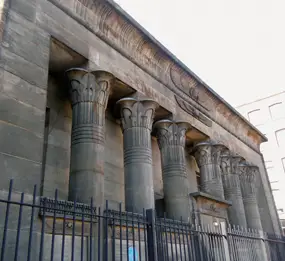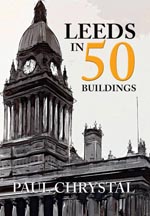Temple Works Leeds – A Lost Architectural Marvel

By Paul Chrystal
A Grade I-listed Victorian former flax mill that has gone down in history as containing the largest room in the world, with sheep grazing on a skylit roof amid an industrially revolutionised Leeds. The breathtaking façade is modelled on the Temple of Horus at Edfu in Egypt.
Temple Works was designed by Joseph Bonomi the Younger and constructed by John Marshall between 1836 and 1840. To this day it is referred to in schools of architecture and engineering the world over not just for the truly awesome façade but also for the unique and visionary engineering solution used for the main mill floor, reminiscent of Frank Lloyd Wright’s Johnson Wax Building completed one hundred years later in Racine, Wisconsin. Up until 1981 it was the northern headquarters of the mail-order catalogue company Kay’s from 1953 until its closure in 1981 when they moved to a four-storey warehouse in Sweet Street. Kay’s was the largest employer in south Leeds.
From 2009 Temple Works Leeds has been a thriving cultural hub that is given over to 20 per cent heritage and education, 40 per cent location shoots and in-house studio events, and 40 per cent public events.

Joseph Bonomi the Younger’s Leeds temple – no sign of any sheep today. Apart from this wonderful façade, Bonomi was also responsible for Nineveh and its Palaces and other works on Egypt, Nubia, and Ethiopia, illustrated with his own drawings; a house, The Camels, at Wimbledon; and for inventing a machine for measuring the proportions of the human body, about which The Proportion of the Human Figure was published in 1856
“The sheep were not just a gimmick”
Temple Works, or Temple Mill, comprised an office block and factory, the former being based on the temple at Antaeopolis and Temple of Horus at Edfu with a chimney in the shape of an obelisk; the factory building was modelled on the Typhonium at Dendera. Benjamin Hick’s 240-HP beam engine featured Egyptian details including a regulator in the form of a winged solar disk. The Egyptian influence came from Marshall’s intense interest in Egyptology. The sheep were not just a gimmick: they helped retain humidity in the flax mill to prevent the linen thread from becoming dried out and unworkable. Sheep, of course, are not very good at climbing ladders or stairs so, to get them onto the roof and down again, the hydraulic lift had to be invented – and so it was.

Another shot of Joseph Bonomi the Younger’s Leeds temple showing the magnificent columns and capitals
According to Susan Williamson, director of the cultural project Temple Works Leeds: “The roof was originally grassed and mowed by sheep. It was grassed to wick the moisture from the air and bring it down the rainwater pipes to make steam with water from the nearby Hold Beck to power all of the machinery here. With all of the solar energy gained from the skylights, it was able to have a solid 78-degree temperature to keep the air moist and keep the flax from breaking.”
In 1842 there was trouble at the mill with the Plug Plot Riots (the 1842 General Strike). They acquired the name ‘Plug’ because the mills ‘were stopped from working by the removal or “drawing” of a few bolts or “plugs” in the boilers so as to prevent steam from being raised’ (OED).
The Leeds Annals described the events: “The vicinity of the new mill in Marshall Street was completely crammed with an excited mob, many of whom were armed with bludgeons, stones & c. The yard-door leading to the boilers of the new mill was strongly defended by Mr J. G. Marshall, and a number of workmen; but the mob by repeated efforts forced down the door, and rushed into the yard.
“Social responsibility”
They could not find the plug of the boiler, and consequently did not succeed in stopping the mill. They left the premises without having done any serious mischief, and then proceeded to the mill of Messrs Titley, Tatham and Walker, Water Lane, which they were engaged in stopping when Prince George with the Lancers came up at full speed and formed in a line in Camp Field. The riot act was read, and two or three of the ringleaders were taken prisoners.”
 All rather unfortunate because Marshall was one of the pioneers of workers’ safety and education and did much to mitigate the dangers inherent in running and working in a textile mill. He was only too aware of the flammability of textiles and so built twenty-five fire escapes into his building; multi-storey spelled death trap with carnage and mayhem a possibility on stairways so he made Temple Works single storey.
All rather unfortunate because Marshall was one of the pioneers of workers’ safety and education and did much to mitigate the dangers inherent in running and working in a textile mill. He was only too aware of the flammability of textiles and so built twenty-five fire escapes into his building; multi-storey spelled death trap with carnage and mayhem a possibility on stairways so he made Temple Works single storey.
Like Rowntree, Titus Salt and Cadbury he felt a social responsibility towards his workers and their families: the undercroft housed children’s dormitories, shops, doctors, a church; there was a school adjacent to the mill at ground level. The children, until aged twelve, were well looked after while their parents worked to bring home the bacon.
Extract from the book ‘Leeds in 50 Buildings’, courtesy of Paul Chrystal, available from Amberley Publishing









